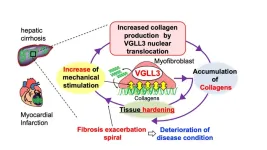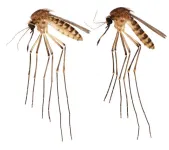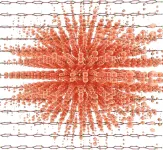(Press-News.org) MIAMI, FLORIDA (EMBARGOED UNTIL WEDNESDAY, MARCH 22, 2023 AT 10 A.M. ET) – Researchers have shown for the first time exactly how immature neutrophils – white blood cells that are an important part of the immune system – are hijacked by pancreatic cancers to drive immunosuppression and treatment resistance. The study, led by investigators at Sylvester Comprehensive Cancer Center at the University of Miami Miller School of Medicine, is published in Cancer Discovery, a journal of the American Association for Cancer Research.
The paper describes a previously unrecognized signaling circuit in pancreatic cancer that instigates immunosuppression and tumor-promoting inflammation in the pancreatic tumor microenvironment, ultimately creating treatment resistance. The central regulator of this treatment resistance is neutrophil-derived TNF signaling. TNF, or tumor necrosis factor, is a substance in the body that causes inflammation.
This is the first study to implicate immunosuppressive signaling from immature neutrophils – the earliest sentinels in developing pancreatic cancer – in this process, said Jashodeep Datta, M.D., associate director of Translational Research at the Sylvester Pancreatic Cancer Research Institute. Datta, whose laboratory at Sylvester led the research, is senior author of the multicenter study.
“It suggests neutrophils are a dominant actor in this circuit. This is the first description of how cancer cells talk with neutrophils and how neutrophils are major actors in this immunosuppressive inflammatory drama in the pancreatic tumor microenvironment,” said Datta, the DiMare Family Chair in Immunotherapy at the Miller School.
He said the research is critical to scientists’ knowledge of pancreatic cancer – one of the most treatment-resistant cancers – because it “connects the molecular dots between the high-risk tumor genotypes that exist in pancreatic cancer and the specific molecular and cellular culprits – the immature neutrophils – that are involved in creating immunosuppressive networks in the pancreatic tumor microenvironment.” The research team, Datta said, is “creating a road map to target each element of these molecular dots” to thwart this inflammatory process and overcome therapeutic resistance.
Nipun Merchant, M.D., the founding director of the Sylvester Pancreatic Cancer Research Institute and a co-author of the paper, said the research “will pave the way to the ultimate goal of clinical studies, so that our findings can be directly translated to improve patient care.”
Datta said clinical trials will attempt to target the immunosuppressive pathway from numerous angles.
“We’re collaborating with multiple groups across the country to make this happen and are developing a novel nanoengineering platform to target neutrophils without killing them so we can target the tolerogenic [immunosuppressive] signaling mechanisms within neutrophils,” he said.
To make the discovery, the Sylvester team collaborated with researchers in different disciplines at the Miller School, including the departments of Microbiology and Immunology, the Diabetes Research Institute, and Public Health Sciences. They also worked with colleagues at other medical schools and cancer centers, including Johns Hopkins, the University of Pennsylvania, and Harvard.
The researchers leveraged cutting-edge technologies, including single-cell biology, where they used spatial techniques to understand cellular relationships in the pancreatic tumor microenvironment. They used high-dimensional sequencing to understand how cancer cells and neutrophils orchestrate this crosstalk. They brought it all together with mechanistic and translational studies using certain drugs to overcome chemotherapy resistance in cellular and animal models, as well as by using blood samples and tissue specimens made available by patients at Sylvester.
# # #
Additional authors/institutions: A full list of authors and institutions participating in this research is published with the Cancer Discovery article.
Funding: This work was supported by KL2 career development grant by the Miami Clinical and Translational Science Institute (CTSI) under NIH Award UL1TR002736, American College of Surgeons Franklin H. Martin Research Fellowship, Association for Academic Surgery Joel J. Roslyn Faculty Award, Society of Surgical Oncology Young Investigator Award, Elsa U. Pardee Foundation Award, and Pancreatic Cancer Action Network Career Development Award (to J. Datta); NIH R01 CA161976 (to N. B. Merchant). Research reported in this publication was supported by the NCI/NIH Award P30CA240139.
Disclosures/conflicts of interest: The authors declare no potential conflicts of interest.
DOI: 10.1158/2159-8290.CD-22-1046.
# # #
MEDIA CONTACT:
Sandy Van
sandy@prpacific.com
808.206.4576
END
Effective energy storage is paramount to society’s transition to renewable energy. Lithium metal batteries (LMBs) have the potential to double the amount of energy stored in a single charge compared to current lithium ion batteries (LIBs), but lithium dendrite growth and electrolyte consumption in current LMB technologies are hindering battery performance. Substrates for solid polymer electrolytes (SPEs) offer a potential solution to current LMB limitations, but SPEs require their own optimization prior to integration into all-solid-state LMB (ASSLMB) systems.
A ...
As an international study involving University of Gothenburg researchers has shown, a decision tool for health professionals has proved capable of halving the use of antibiotics against urinary tract infections while maintaining patient safety.
The study, now published in The BMJ, comprises a total of 1,041 frail older people at 38 senior care homes in the Netherlands, Norway, Poland, and Sweden. A group of researchers at the University of Gothenburg and Region Västra Götaland has been running the Swedish part of the study, ...
A promising cancer drug that targets only cancer cells has been developed by researchers from the Norwegian University of Science and Technology (NTNU) and a university spin-off company, APIM Therapeutics.
NTNU has been responsible for the basic research. APIM Therapeutics has used the basic research to develop the medicine.
It has taken 18 years and more than EUR 20 million.
The medicine has now been tested on 20 cancer patients who were terminally ill. They had tried all available treatments, and as a last resort they opted ...
Fukuoka, Japan—Researchers from Kyushu University have found how a single mechanosensitive protein induces the process that thickens and scars tissue, known as fibrosis. The protein, called VGLL3, was shown to contribute to fibrosis in multiple organs.
The team hope their findings will lead to new treatments against fibrosis, a pathology that is attributed to 45% of all deaths in industrial nations. Their study was published in Nature Communications.
In response to any injury, the body immediately begins a stream of events. Blood coagulates, the tissue ...
CHICAGO – March 21, 2023 – A new study from VillageMD Research Institute, in collaboration with a scientist from Harvard-affiliated Marcus Institute for Aging Research, demonstrates the prevalence of frailty in both middle-aged and older adults and frail patients’ challenges in accessing healthcare in the United States. This study was recently published in the Journal of the American Medical Directors Association titled “Self-Reported Frailty and Health Care Utilization in Community-Dwelling Middle-Aged and Older Adults ...
Researchers from University of Pennsylvania, University or Maryland, and Emory University published a new Journal of Marketing article that examines how and why the language used in content engages readers.
The study, forthcoming in the Journal of Marketing, is titled “What Holds Attention? Linguistic Drivers of Engagement” and is authored by Jonah Berger, Wendy W. Moe, and David A. Schweidel.
Everyone wants to hold an audience’s attention. Brands want consumers ...
Another new mosquito species has made its way across the tropics into Florida, making a permanent home in at least three counties. Scientists are concerned because of the rate of new mosquitoes arriving in Florida and the potential for them to transmit mosquito-borne diseases.
A mosquito known only by its scientific name, Culex lactator, is the latest to establish in the Sunshine State, according to a new study published in the Journal of Medical Entomology by faculty at the UF/IFAS Florida Medical Entomology Laboratory (UF/IFAS FMEL).
This species was first discovered ...
A new leaf has turned in scientists' hunt for developing cutting-edge materials used in organic light-emitting diode (OLED) TV's, touchscreens, and more. The advance involves the polaron, a quasiparticle consisting of an electron and its surrounding distortions of atoms in a crystal lattice.
Simulations on the Texas Advanced Computing Center's (TACC) Frontera supercomputer have helped scientists map for the first time the conditions that characterize polarons in 2D materials, the thinnest materials that have ever been made.
"We charted a map to indicate in which materials polarons should be found, under what conditions, and the characteristics ...
Nearly a third of Americans (29%) say COVID-19 made them more worried than ever about having obesity prompting about 28 million people to consider weight-loss methods they hadn’t thought about before the pandemic began, including nearly 6.4 million thought about turning to either weight-loss surgery or taking prescription anti-obesity drugs for the first time, according to a new survey whose findings were published online in the peer-reviewed journal, Surgery for Obesity and Related Diseases (SOARD).
Another nearly 1 in 5 people (18%) said they were more likely to initiate a discussion about their weight with their physician specifically because ...
Following enormous collisions, such as asteroid impacts, some amount of material from an impacted world may be ejected into space. This material can travel vast distances and for extremely long periods of time. In theory this material could contain direct or indirect signs of life from the host world, such as fossils of microorganisms. And this material could be detectable by humans in the near future, or even now.
When you hear the words vacuum and dust in a sentence, you may groan at the thought of having ...






